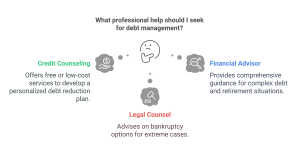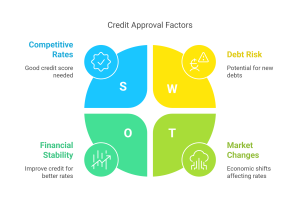Are you making payments month after month but still seeing your debt grow? You’re not alone. For many Americans like you, creating a structured debt reduction plan is the key to breaking free from financial stress and building a secure future. Whether you’re dealing with stubborn credit card balances, a lingering car loan, or multiple debts stretching your budget thin, there’s a path forward.
What Exactly Is a Debt Reduction Plan, and Why Do You Need One?
A debt reduction plan isn’t just about paying bills on time—it’s your personalized roadmap to financial freedom. Think of it as a GPS guiding you from debt stress to financial peace, with clear routes and milestones along the way.
“Without a concrete debt reduction plan, you’re essentially hoping things get better rather than making them better,” explains financial advisor Rebecca Martinez.
An effective debt reduction plan typically include the followings:
- A complete inventory of all your debts (with interest rates and terms)
- A realistic budget that maximizes your debt repayment potential
- A specific strategy tailored to your financial situation and personality
- Timeline milestones to track your progress and stay motivated
- Contingency plans for when life throws curveballs your way
Are You Drowning in Debt Like Millions of Other Americans?
If you’re feeling overwhelmed by debt, you’re in good company. The average American household carries approximately $8,942 in credit card debt alone, according to recent Federal Reserve data. When mortgages, auto loans, and student loans enter the picture, it’s no wonder many people feel like they’re treading water financially.
For someone juggling a $220,000 mortgage, $10,000 in credit card debt across multiple cards, and a $12,000 car loan, creating a structured debt reduction plan isn’t just helpful—it’s essential for future financial security and peace of mind.
Which Debt Reduction Method Will Actually Work for Your Situation?
The “best” method for your debt reduction plan depends on your financial situation, personality type, and specific goals. Let’s explore the most effective approaches:
The Debt Snowball Method
How it works: Pay minimum payments on all debts, then put any extra money toward your smallest balance first. Once that’s paid off, roll that payment amount to the next smallest debt.
Best for: People who need psychological wins to stay motivated.
If you have a credit card with a $2,000 balance and another with $8,000, you will focus on eliminating that $2,000 debt first, regardless of interest rates. Each debt you knock out completely gives you the momentum to tackle the next one.
The Debt Avalanche Method
How it works: Focus on paying off the debt with the highest interest rate first while making minimum payments on everything else.
Best for: Those who want to minimize the total interest paid and prefer mathematical efficiency over quick wins.
If your credit cards have interest rates of 22% and 17%, while your car loan is at 5%, your debt reduction plan will prioritize that 22% card first to minimize interest costs.
Debt Consolidation
How it works: Combine multiple debts into a single loan with (ideally) a lower interest rate.
Best for: People with good credit who qualify for favorable rates and want simplicity in their debt reduction plan.
With $10,000 in credit card debt across multiple cards, you might benefit from consolidating these into a personal loan at a lower interest rate or using a balance transfer credit card with a promotional 0% interest period.
How Do the Most Popular Debt Reduction Strategies Really Compare?
| Strategy | Pros | Cons | Best For |
| Snowball Method | Builds momentum through early wins | May pay more total interest | Those needing motivation |
| Avalanche Method | Saves the most money long-term | Takes longer to see the first debt eliminated | Mathematical thinkers |
| Debt Consolidation | Simplifies payments, potentially lower interest | Requires good credit, may have fees | Those with multiple high-interest debts |
| Debt Management Plan | Professional guidance, possibly reduced rates | This may affect credit access temporarily | Those needing structured support |
Ready to Create Your Personal Debt Reduction Blueprint?
Step 1: Know Where You Stand
Start by gathering all your financial statements and listing every debt with the following:
- Current balance
- Interest rate
- Minimum monthly payment
- Payment due date
This comprehensive inventory is the foundation of your debt reduction plan. Be thorough—don’t leave anything out, even small balances.
Step 2: Build a Realistic Budget
You can’t implement an effective debt reduction plan without knowing exactly where your money goes. Track your spending for at least a month, then create a budget that prioritizes debt repayment while covering essentials.
[Insert image of sample budget spreadsheet here]
With an $80,000 household income, you might discover you can redirect an additional $300 monthly toward debt by reducing dining out and subscription services—that’s $3,600 per year directly attacking your debt!
Step 3: Choose Your Strategy and Set Goals
Based on what you’ve learned about different approaches, select the one that best fits your situation and personality. Then, set specific milestone goals with dates to keep your debt reduction plan on track.
A combined approach might work best for many people:
- Transfer balances to a 0% promotional card if possible
- Use the snowball method to tackle remaining debts
- Goal: Eliminate credit card debt within 24 months
Step 4: Find Extra Money to Accelerate Your Debt Reduction Plan
Consider these proven ways to find additional money to supercharge your debt payoff:
- Negotiate bills (cable, phone, insurance)
- Temporarily pause retirement contributions (except employer match)
- Sell unused items around the house
- Take on a side gig for dedicated debt repayment funds
- Use tax refunds and bonuses exclusively for debt payoff
Step 5: Implement Safeguards to Prevent New Debt
While working through your debt reduction plan, it’s crucial to prevent new debt accumulation:
- Create a $1,000 mini emergency fund before aggressive debt payoff
- Use cash or debit cards for purchases
- Remove saved credit card information from online shopping sites
- Practice a 48-hour rule for non-essential purchases
Is Debt Consolidation the Right Move for Your Financial Situation?
For someone with $10,000 in credit card debt, consolidation could be a game-changing component of your debt reduction plan, potentially saving thousands in interest.
Debt consolidation works by combining multiple debts into a single loan with a lower interest rate. This approach offers two key benefits:
- A single monthly payment instead of juggling multiple due dates
- Potentially significant interest savings to accelerate your debt reduction plan
Example: If you have two credit cards with interest rates of 19% and 22%, with balances of $4,000 and $6,00,0 respectively, and you qualify for a debt consolidation loan at 9% interest for three years, your monthly payment would be about $319, and you’d save approximately $3,700 in interest over the life of the loan.
However, consolidation isn’t right for everyone’s debt reduction plan. You typically need:
- A credit score of at least 650-680 for competitive rates
- Stable income to ensure you can make the new payment
- Discipline to avoid running up new debts on the cleared credit cards

Debt Consolidation vs. Debt Settlement: Do You Know the Crucial Difference?
Many people confuse these two very different approaches when considering a debt reduction plan:
Debt Consolidation:
- Combines multiple debts into one loan
- You repay 100% of what you borrowed
- Minimal negative impact on credit score
- Works well within a comprehensive debt reduction plan
Debt Settlement:
- Negotiates with creditors to accept less than what you owe
- Typical, itly requires you to stop making payments during negotiations
- It can significantly damage your credit score for up to seven years
- This may result in taxable “forgiven debt” income
- Should generally be considered only when more traditional debt reduction plan options aren’t viable
How Will a Debt Reduction Plan Affect Your Credit Score?
One common concern about implementing a debt reduction plan is its impact on your credit score. The truth? It depends on which approach you choose:
- Debt Snowball/Avalanche: Generally positive impact as you make consistent payments and reduce overall debt
- Debt Consolidation: This may cause a temporary dip (from the credit inquiry and new account) but often improves scores long-term as utilization decreases
- Debt Management Plans: You could initially lower your score if accounts are closed, but regular payments typically improve scores over time.
- Debt Settlement: Significant negative impact that can last for years
Remember that while your credit score is important, it shouldn’t be the only factor in choosing your debt reduction plan. Financial peace and building wealth should be your ultimate goals.
What If Your Debt Feels Completely Overwhelming?
If you’ve tried creating a debt reduction plan but still feel overwhelmed, professional help may be the answer. Consider these options:
Credit Counseling: Non-profit agencies like the National Foundation for Credit Counseling offer free or low-cost counseling and can help you develop a personalized debt reduction plan.
Financial Advisor: For more complex situations involving multiple types of debt and retirement concerns, a fee-only financial advisor can provide comprehensive guidance.
Legal Counsel: In extreme cases, bankruptcy might be the most responsible option. Consult with an attorney who specializes in bankruptcy law to understand if this makes sense for your situation.

Ready to Take Control of Your Financial Future?
Starting a debt reduction plan may feel daunting, but remember—every successful debt payoff journey begins with a single step. The sooner you begin, the sooner you’ll experience the freedom of watching your debt balances shrink month after month.
Begin today by taking inventory of your debts and creating your budget. Next week, choose your strategy and set your timeline. Within 30 days, you could be well on your way to financial freedom.
Have you implemented a debt reduction plan that worked for you? Share your experience in the comments below. Iff you found this guide helpful, subscribe to our newsletter for more practical financial tips delivered straight to your inbox.
Remember: Your debt doesn’t define you, but how you tackle it might just redefine your future.

























